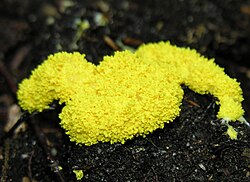| Fuligo | |
|---|---|
 | |
| Fuligo septica | |
| Scientific classification | |
| Domain: | Eukaryota |
| Clade: | Amorphea |
| Phylum: | Amoebozoa |
| Class: | Myxogastria |
| Order: | Physarales |
| Family: | Physaraceae |
| Genus: | Fuligo Haller (1768) |
Fuligo is a widespread genus of plasmodial slime mold in the family Physaraceae. [1] These organisms are protozoans rather than fungi, but for historical reasons are sometimes treated as part of mycology.